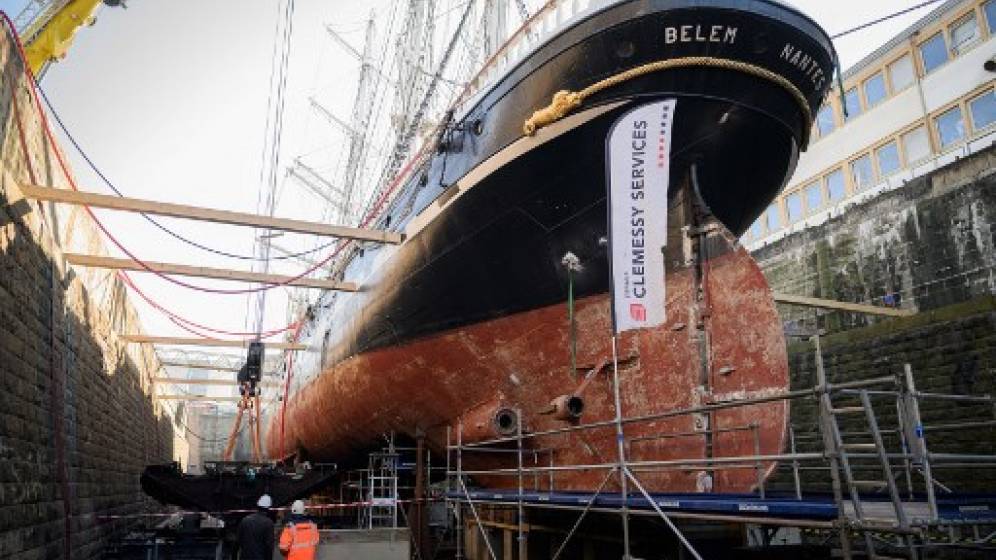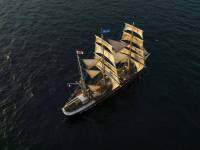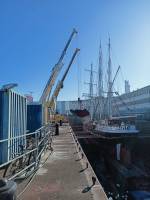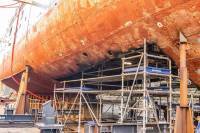La période d’hivernage sera propice pour restaurer la coque du Belem, navire classé monument historique depuis 1984. Cette opération délicate est financée à hauteur de 40 % (soit plus de 680 000 €) par la DRAC. Les travaux sont réalisés en cale sèche dans les chantiers navals de Saint-Nazaire par le groupe Eiffage Énergie Systèmes sous le contrôle scientifique et technique de la DRAC.
Un bateau emblématique de l’histoire navale nantaise
Construit par les chantiers Dubigeon de Chantenay en 1896, le Belem est une commande de l’armateur nantais Fernand Crouan. Le navire est dans un premier temps dédié au commerce : il effectue ainsi trente-trois campagnes transatlantiques vers le Brésil puis vers la Guyane et les Antilles. Du Brésil, il rapporte du cacao pour les chocolateries Meunier et des Antilles, du rhum et du sucre.
En 1914, le fameux trois-mâts est racheté par le duc de Westminster qui le transforme en yacht de plaisance. En 1921, le brasseur irlandais Sir Arthur Guinness en fait l’acquisition. Il effectue le tour du monde à bord du navire, alors rebaptisé Fantôme.
Le Belem demeure aujourd’hui l’un des plus anciens trois-mâts d’Europe et le dernier trois-mâts barque français à coque acier. Chaque année, il navigue plusieurs mois en Europe sous autorisation du ministère de la Culture par l’intermédiaire de son service déconcentré, la DRAC des Pays de la Loire.
Puis, après avoir appartenu à la Fondation Cini, l’Union Nationale des Caisses d’épargne rachète le Belem et en fait don à la Fondation qui porte son nom. Cette dernière en est l’actuelle propriétaire depuis 1980.
Une importante restauration suivie et financée par la DRAC Pays de la Loire
Depuis son classement au titre des Monuments historiques en 1984, le Belem a fait l’objet de nombreuses restaurations, autorisées et subventionnées par l’État qui ont permis de sauvegarder ce symbole nantais et national.
Fleuron de la marine à voile de la fin du 19e siècle, le Belem se distingue par sa coque en métal riveté qui devait garantir la solidité, la rapidité et la maniabilité du bateau. La cale, principalement d’origine, est aujourd’hui en mauvais état. Usée et corrodée, elle doit être remplacée afin que le navire puisse continuer à naviguer. L’opération, très délicate, consiste à ouvrir la coque pour en extraire l’ancien bloc-cale métallique et y insérer le nouveau.
La restauration de la coque doit être réalisée en cale sèche dans les chantiers navals de Saint Nazaire selon un calendrier contraint, celui de l’hivernage 2022-2023 (de décembre 2022 à avril 2023). La DRAC, chargée du contrôle scientifique et technique sur le patrimoine protégé au titre des monuments historiques, a accompagné étroitement la Fondation Belem dans l’établissement du programme de travaux en apportant son expertise et participe à leur financement.
Ces travaux de grande envergure ont un coût de 1 723 705 euros hors taxe que la DRAC des Pays de la Loire subventionne à hauteur de 40 %, soit 689 482 euros. Cette restauration complexe est réalisée par le groupe Eiffage Énergie Systèmes sous le contrôle scientifique et technique de la DRAC des Pays de la Loire.
Une politique active de soutien au patrimoine maritime et fluvial
Depuis les années 1980, le ministère s’est emparé des questions liées au patrimoine industriel et notamment au patrimoine maritime et fluvial, ce qui s’est traduit par une vague de protections au titre des monuments historiques. En Pays de la Loire, 28 bateaux sont protégés, (bateaux militaires, de prestige, de pêche, de régate, de plaisance, bateau-école… ).
La DRAC accompagne chaque année des travaux de restauration sur ces monuments qui continuent à naviguer. Le rôle de la DRAC est de veiller à la préservation du monument historique tout en favorisant autant que possible le maintien de l’usage. Ces dernières années, des restaurations importantes ont été réalisées sur le Belem (restauration du grand et du petit roof), le Chantenay (restauration de la coque), ou le Kifanlo, chalutier des Sables organisant des sorties-démonstrations (restauration générale), sans compter de petites interventions plus ponctuelles, pour un total de 1 064 703 € ces cinq dernières années.
Des opérations importantes s’annoncent pour les années à venir, sur des bateaux emblématiques du territoire, comme le Maillé-Brézé, ou encore le Léchalas, opérations également accompagnées scientifiquement, techniquement et financièrement par la DRAC.
Partager la page




